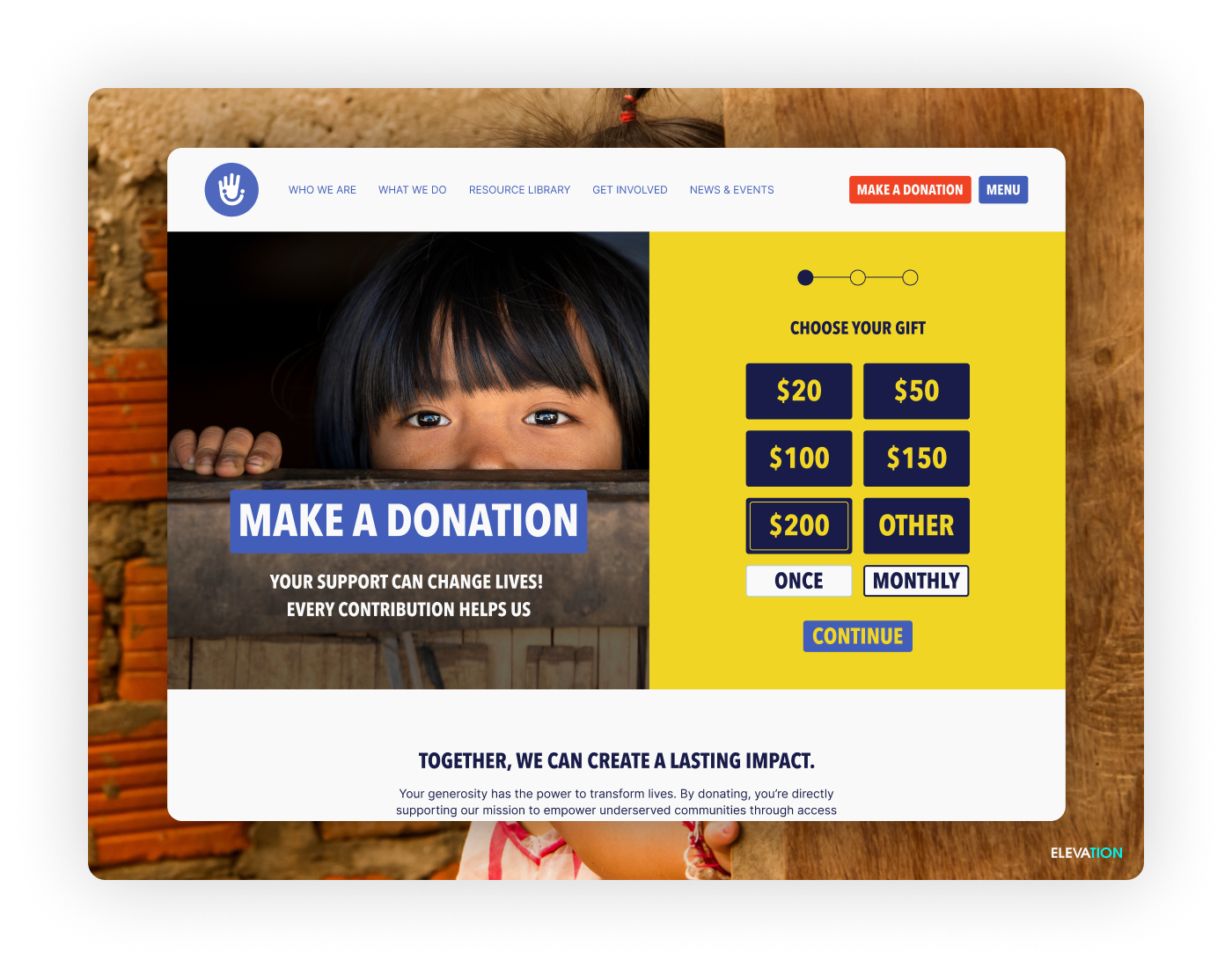Refining your marketing techniques is key for reaching your nonprofit fundraising goals, but organizations often put marketing on the back burner. With all the other tasks you may supervise in your leadership role, from managing volunteers to retaining the support of major donors, it’s common for marketing to take a back seat in your nonprofit’s overall strategy.
Implementing a comprehensive communication plan to market your fundraising opportunities effectively will be the foundation of your organization’s success. After all, you won’t be able to gain new supporters if no one’s heard of your cause!
Marketing for fundraising organizations doesn’t have to be an inconvenience. Create a clear-cut marketing strategy now to provide a blueprint for any future marketing efforts. Use these four methods to ensure your marketing plan is a success:
- Take a multichannel marketing approach
- Make sure your messaging prompts further engagement
- Share compelling stories that demonstrate value
- Invest in marketing software that enables the above strategies
Your marketing plan will raise awareness of your cause among your target audience and expand your organization’s reach. This plan works in harmony with the rest of your organization’s strategy to ultimately allow you to carry out your mission more productively. Here’s how each of these methods contributes to your fundraising success:
1. Take a multichannel marketing approach
To maximize the effectiveness of your outreach platforms, take a multichannel marketing approach. Multichannel marketing means reaching out to supporters through a range of communication methods.
Certain audiences respond differently to different types of marketing messages—for example, older populations are most responsive to direct mail, while the younger crowd typically interacts more on social media—and a multichannel strategy gives you the best chance of reaching an audience across generations. Additionally, it can take 18-20 touchpoints to reach a donor for the first time, and using multiple marketing channels gives you the best chance of reaching your audience.
To reflect the aforementioned varying demographic preferences, strike a balance between direct marketing and mass marketing. Direct marketing is marketing targeted toward individuals, and mass marketing is aimed at a wider audience. Direct marketing includes the basics like sending fundraising letters through the mail to supporters’ addresses, sending email messages, or making phone calls, while mass marketing includes wide-net approaches like social media posts, advertising spots, or billboards.
Use the additional marketing techniques below to reinforce your fundraising message by playing to the strengths of each channel you invest in. In the next section, we’ll dive into using messaging tactics to promote further supporter engagement on each platform.
2. Use your messaging to encourage further engagement
Ensure your fundraising and marketing appeals are crafted to encourage supporters to convert or complete another desired action. In each marketing channel, incorporate specific calls-to-action asking recipients to donate, volunteer, join your mailing list, or whatever action you want them to take. Specific actions you can take for both your direct and mass marketing campaigns include:
- Send direct mail messages that are easy to read and get right to the point. Some direct mail platforms offer a direct mail template to input your organization’s appeal and call-to-action. In your direct mail materials, be precise about your fundraising request, provide multiple donation options (such as sending a donation back through the mail or contributing a gift on your website), and include your organization’s contact information. You don’t have endless room on your direct mail letters to share informations about your organization’s fundraiser, so be sure to keep it concise and easy to comprehend.
- Craft emails with multiple points of interaction. With email marketing, you have the opportunity to provide a little more context for your request, but you should still keep your message brief. Make your appeal succinct and include your social media widgets and website link to provide opportunities for further engagement. Give recipients the ability to reply directly to your emails with any questions to address their concerns immediately.
- Boost interaction with your audience on social media. Make posts interactive, such as by asking questions and running polls, because interactive posts achieve higher click-through rates (the click-through rate is the percentage of users who click on links in posts). Additionally, use relevant hashtags to amplify the reach of your posts, and always respond to messages and inquiries from your followers. If your followers are asking questions about your donation process or volunteer sign-up procedure, you want to give a response ASAP to convert them into engaged supporters.
Providing subtle, but numerous, access points where your audience can learn more about your organization will encourage them to become more involved. Your donors will appreciate hearing about non-fundraising updates at your organization, too, so be sure to also send messages with information about your organization’s recent activities and how you’re working toward your mission. These updates help foster a greater connection with your audience as they become invested in your organization’s progress.
3. Share compelling stories that demonstrate value
Effective storytelling can help supporters sympathize with your cause and lead more donors to support your fundraising efforts.
Again, craft your stories to fit different audiences and platforms. For example, you can use a social media campaign to tell the history of your nonprofit through a series of posts or create a sequence of emails that include testimonials of several people your organization has assisted.
Pair stories with data that demonstrates your organization’s impact. Hook the reader with a compelling narrative, then back it up concrete facts that communicate your organization’s impact.
You can use your social media pages to solicit user-generated content, too. Ask supporters to share stories about their personal experiences with your cause and their connection to your organization. These are the most impactful stories because they come right from your supporters, in their own words.
Lastly, you can assess the effectiveness of your messages with A/B testing. This guide to nonprofit digital campaigns explains that A/B testing consists of sending two different variations of the same message to see which yields the best results. You can A/B test the wording of your appeals in your direct mail materials or your email subject lines to see which version generates the most conversions.
4. Invest in the right marketing software
Marketing software is an investment that has the potential to raise a great deal of funds for your organization when implemented correctly. Before investing in a software provider, do research to make sure it meets all your organization’s most important needs. For example, if your organization has a large Gen Z audience, the solution you choose should facilitate both traditional direct mailings and new outreach methods, such as social media platforms.
To ensure you’re covering all marketing bases, here are the different types of software you’ll want to consider:
- Direct mail marketing platform. Most individual donations in the United States still come from direct mail. When researching which direct mail marketing provider is right for your nonprofit, consider factors such as cost, the provider’s level of experience, any templates offered and the level of personalization included, and the provider’s willingness to answer questions and share knowledge.
- Nonprofit CRM. Your CRM houses pertinent supporter information such as demographics, donor history, and contact information. The right nonprofit CRM will allow you to organize supporters into different segments to send out personalized marketing messages to each group. DNL OmniMedia’s guide to donor segmentation gives examples of how this contributes significantly to donor retention, as donors appreciate receiving only information that is relevant to them.
- Email marketing software. More than half of the world’s population uses email, so it’s safe to say that this channel should also play a major role in your marketing strategy. Choose an email marketing platform that integrates with your CRM to seamlessly sync your supporter contact lists. Popular email options include Mailchimp and Constant Contact, but your CRM might also provide an email marketing tool.
- Social media marketing software. Similarly, over half of the world’s population is on social media. If your nonprofit has resisted joining social media or deprioritized your social accounts, it’s time to get onboard with this digital marketing avenue. Software such as Hootsuite, Buffer, and Sprout Social allow users to create and schedule social media content in advance and use analytics to gauge the effectiveness of social campaigns. When searching for the right social media software for your organization, research pricing, read customer reviews, and request walk-throughs to get a full picture of each option before investing.
The marketing software platforms above each play a different role in your marketing toolkit; for a robust fundraising strategy you’ll need the ability to do all as part of your multichannel approach.
Each of these marketing tips can lead your fundraising organization on a path to greater community engagement. When you take your marketing strategy seriously, you set up your whole organization for success in the future. Do your research to figure how to make these strategies work for your organization. Best of luck!



